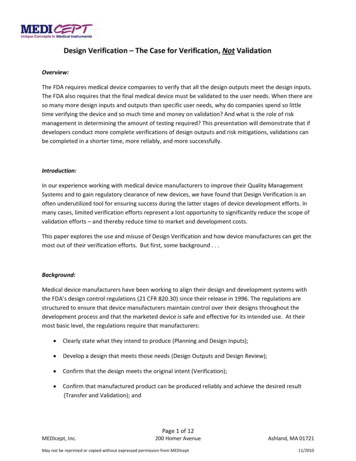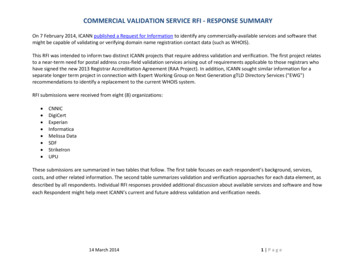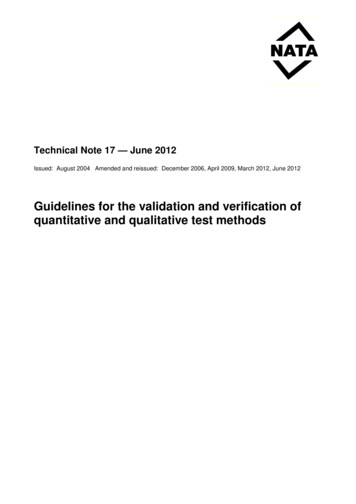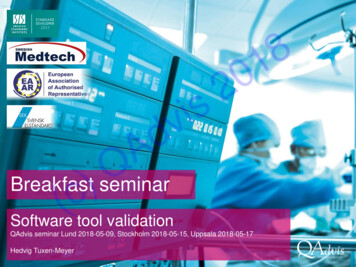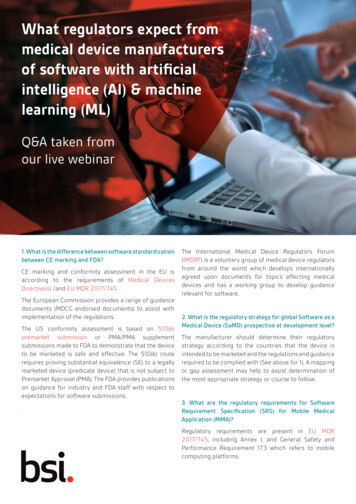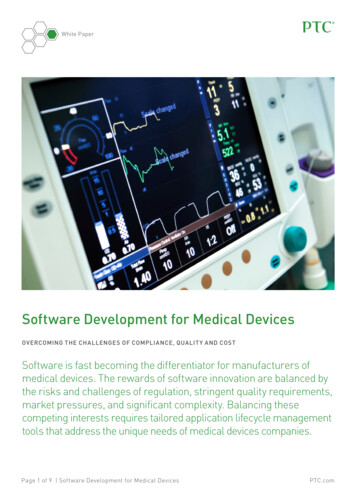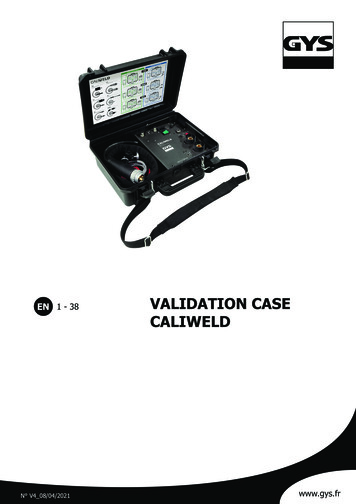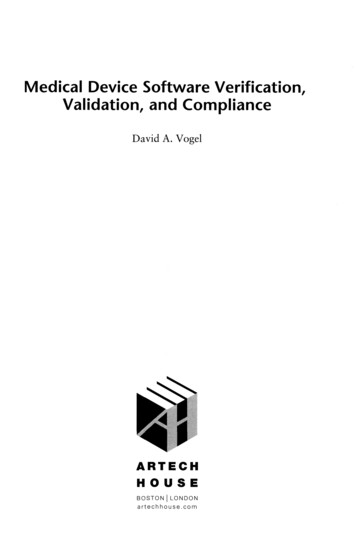
Transcription
Medical Device Software Verification,Validation, and ComplianceDavid A. VogelARTECHHOUSEBOSTON LONDONartechhouse.com
ContentsPrefaceThe Author's Background and Perspective of PTER 1The Evolution of Medical Device Software Validation andthe Need for This Book3The Evolution of Validation in the Medical Device IndustryBuilding a Language to Discuss ValidationTerminology is the FoundationCorrect Versus Consistent TerminologyTerminology Need Not Be EntertainingRisk Management and Validation of Medical Device SoftwareAbout This BookGoals of This BookIntended AudienceAre You Wasting Time?References34567889101212\ П/А1 I L i \ Z.Regulatory Background13The FDA: 1906 Through 1990The FDA Today (2009)How the FDA Assures Safety, Efficacy, and SecurityQuality System Regulations and Design ControlsUnderstanding How Regulation Relates to Getting the Job DoneMedical Devices Sold Outside the United StatesReferences13161720222425
ContentsVIIICHAPTER 3The FDA Software Validation Regulations and Why You ShouldValidate Software AnywayWhy the FDA Believes Software Should Be ValidatedTherac 25Building ConfidenceThe Validation RegulationsWhy You Should Validate Software AnywayReferencesCHAPTER 4Organizational Considerations for Software ValidationRegulatory Basis of Organizational ResponsibilityA Model for Quality SystemsRoles, Responsibilities and Goals for the Quality SystemThe Structure of the Quality SystemQuality System ProcessesQuality System ProceduresThinking Analytically About ResponsibilityUntangling Responsibilities, Approvals, and SignaturesWhat Happened to the Author?The Meaning of Approval: What That Signature MeansSo, What Could Go Wrong with a Design Control Quality System?What Happened?Designing Streamlined RR&A Requirements for the Quality SystemFixing the Problem: Designing a Value-Added Approval/Signature ProcessRegulatory Basis for Treating Approvals and Signatures SeriouslyReferenceCHAPTER 5The Software (Development) Life CycleWhat Is a Software Life Cycle?Software Validation and SDLCs: The Regulatory BasisWhy Are Software Development Life Cycle Models Important?What Do Different Software Development Life Cycle Models Look Like?Waterfall and Modified WaterfallSashimi Modified Waterfall ModelSpiral ModelExtreme Programming: Agile Development ModelsHow Do You Know What Life Cycle Model to Choose?How Do Software Development Life Cycles Relate to the Quality System?The ANSI/AAMI/IEC 62304:2006 StandardAn Organization for the Remainder of This BookReference
CHAPTER 6Verification and Validation: What They Are, What They Are Not75What Validation is NOTValidation and Its Relationship to Verification and TestingSoftware Validation According to Regulatory GuidanceCan Other Definitions of Validation Be Used?User Needs and Intended UsesSoftware Verification According to Regulatory GuidanceHow Design Controls, Verification, and Validation Are RelatedValidation Commensurate with Complexity and RiskIs All Validation Created Equal?Reference75767981828284858787CHAPTER 7The Life Cycle Approach to Software Validation89Validation and Life CyclesCombined Development and Validation Waterfall Life Cycle ModelA Validation Life Cycle ModelThe Generic or Activity Track Life Cycle ModelLife Cycles and Industry StandardsFinal Thoughts on Selecting an Appropriate Life Cycle ModelReferences90919395102103103CHAPTER 8Supporting Activities that Span the Life Cycle: Risk Management105Introduction to Activities Spanning the Life CycleRisk ManagementRisk in the Regulations and Guidance DocumentsISO 14971: Application of Risk Management to Medical DevicesAAMI's TIR32:2004: Medical Device Software Risk ManagementRisk and the IEC 62304 Standard on Life Cycle ProcessesIEC/TR 80002-1: Application of 14971 to Medical Device SoftwareThe Risk Management ProcessThe Language of Risk ManagementRisk Management OutputsThe Risk Management PlanThe Risk Management FileRisk Management Concepts and DefinitionsRisk Management ActivitiesRisk AnalysisQualitative Probability AnalysisIgnoring ProbabilityQualitative ProbabilitiesRisk EvaluationRisk ControlOverall Residual Risk 17117122123123129130134
ContentsSummaryReferences140141CHAPTER 9Other Supporting Activities: Planning, Reviews,Configuration Management, and Defect Management143PlanningDesign and Development PlanningWhy Planning Is ImportantHow Many Plans Are Required?Plan Structure and ContentWhat Does a Plan Look Like?Evolving the PlanConfiguration ManagementRegulatory BackgroundWhy Configuration Management?What Goes into a Configuration Management Plan?Defect (and Issue) ManagementRegulatory BackgroundWhy Defect Management Plans and Procedures Are ImportantRelationship to Configuration (Change) ManagementPlanning for Defect ManagementReviewsRegulatory BackgroundWhy the Focus on Reviews?What Is Meant by a Review?Who Should Be Participating in the Reviews?H o w Reviews Are ConductedTraceabilityWhy Traceability?Regulatory BackgroundTraceability Beyond the Regulatory GuidancePractical Considerations: H o w It Is DoneTrace ToolsTrace MappingCan Traceability Be 185188189189Validation of Medical Device Software191CHAPTER 10The Concept Phase Activities193The Concept PhaseRegulatory BackgroundWhy a System Requirements Specification Is NeededValidation Activities During the Concept Phase193194195196
ContentsXIMake or Buy? Should Off-the-Shelf (OTS) Software Be Part of the Device?The System Requirements SpecificationWho Is the Intended Audience?What Information Belongs in an SyRS?How Are System Requirements Gathered?Further ReadingSelect Bibliography198200200201204205205The Software Requirements Phase Activities207IntroductionRegulatory BackgroundWhy Requirements Are So ImportantThe Role of Risk Management During Requirements DevelopmentWho Should Write the Software Requirements?The Great Debate: What Exactly Is a Requirement?Anatomy of a RequirementHow Good Requirements Are 1231CHAPTER 12The Design and Implementation Phase Activities233IntroductionRegulatory BackgroundValidation Tasks Related to Design ActivitiesThe Software Design Specification(Alias the Software Design Description)Evaluations and Design ReviewsCommunication LinksTraceability AnalysisRisk ManagementValidation Tasks Related to Implementation ActivitiesCoding Standards and GuidelinesReuse of Preexisting Software ComponentsDocumentation of Compiler OutputsStatic 8249250251CHAPTER 13The Testing Phase Activities253IntroductionRegulatory BackgroundWhy We Test SoftwareDefining Software TestingTesting Versus ExercisingThe Psychology of Testing253253255256257258
ContentsXIILevels of TestingUnit-Level TestingUnit-Level Testing and Path CoverageMcCabe Cyclomatic Complexity Metric and Path CoverageOther Software Complexity Metrics and Unit Test PrioritizationIntegration-Level TestingDevice Communications TestingSystem-Level Software TestingSystem-Level Verification Testing Versus Validation TestingTesting MethodsEquivalence Class TestingBoundary Value TestingCalculations and Accuracy TestingError Guess TestingAd Hoc TestingCaptured Defect TestingOther Test MethodsTest Designs, Test Cases, and Test ProceduresManaging TestingThe Importance of RandomnessIndependenceInformal TestingFormal TestingRegression TestingAutomated TestingSummaryReferencesSelect TER 14The Maintenance Phase Validation Activities305IntroductionA Model for Maintenance ActivitiesSoftware Release Activities: Version nCollection of Post-Market DataProcess and PlanningSources of Post-Market DataAnalysisThe Maintenance Software Development Life Cycle(s)Software Development and Validation ActivitiesSoftware Release Activities: Version n tion of Nondevice Software323
XIII(-ontentsCHAPTER 15Validating Automated Process Software: Background325IntroductionRegulatory BackgroundNondevice Software Covered by These RegulationsFactors that Determine the Nondevice Software Validation ActivitiesLevel of ControlType of SoftwareSource of the SoftwareOther Factors That Influence ValidationRiskSize and ComplexityIntended UseConfidence in the Source of the SoftwareIntended UsersIndustry GuidanceAAMI TIR36:2007: Validation of Software for Regulated ProcessesGAMP 5: Good Automated Manufacturing PracticeWho Should Be Validating Nondevice 6337337340341341342343CHAPTER 16Planning Validation for Nondevice Software345IntroductionChoosing Validation ActivitiesDo-It-Yourself Validation or Validation for Nonsoftware EngineersThe Nondevice Software Validation SpectrumLife Cycle Planning of ValidationThe Nondevice Software Validation ToolboxProduct SelectionSupplier SelectionKnown Issue AnalysisSafety in NumbersThird-Party ValidationOutput VerificationBackup, Recovery, and Contingency PlanningSecurity MeasuresTrainingThe Validation 58359360360361CHAPTER 17Intended Use and the Requirements for Fulfilling Intended Use363IntroductionIntended UseWhy It Is Necessary to State Intended UseIntended Use and Validation of Nondevice Software363364364365
ContentsXIVContents of a Statement of Intended UseDetermining Intended UseRequirements for Fulfilling the Intended UseRequirements for Custom-Developed SoftwareRequirements for Acquired SoftwareInformation Content of RequirementsExample: Intended Use and Requirements forValidation of a Text Editor365366369369370370372CHAPTER 18Risk Management and Configuration Management of Nondevice SoftwareActivities that Span the Life Cycle375Risk ManagementApplying the 14971 Risk Management Process to Nondevice SoftwareHarmRisk, Severity, and ProbabilityManaging the RiskControlling the Process to Reduce RiskRisk AcceptabilityDetectabilityConfiguration Management for Nondevice SoftwareWhy Configuration Management Is ImportantConfiguration Management PlanningConfiguration Management 389391392CHAPTER 19Nondevice Testing Activities to Support Validation393Why Test—Why Not To TestTesting as a Risk Control MeasureRegulatory RealitiesTesting Software That Is Acquired for UseIQ, OQ, and PQ TestingValidation of Part 11 Regulated SoftwareSummary393395395396397399400CHAPTER 20Nondevice Software Maintenance and Retirement Activities401Maintenance ActivitiesRelease ActivitiesPost-Release MonitoringRisk Analysis and Risk ManagementSecurityRetirement of SoftwareAbout the Author401402403404405406409Index411
Medical Device Software Verification, Validation, and Compliance David A. Vogel ARTECH HOUSE BOSTON LONDON artechhouse.com . Background 1 CHAPTER 1 The Evolution of Medical Device Software Validation and the Need for This Book 3 The Evolution of Validation in the Medical Device Industry 3 Building a Language to Discuss Validation 4 .
